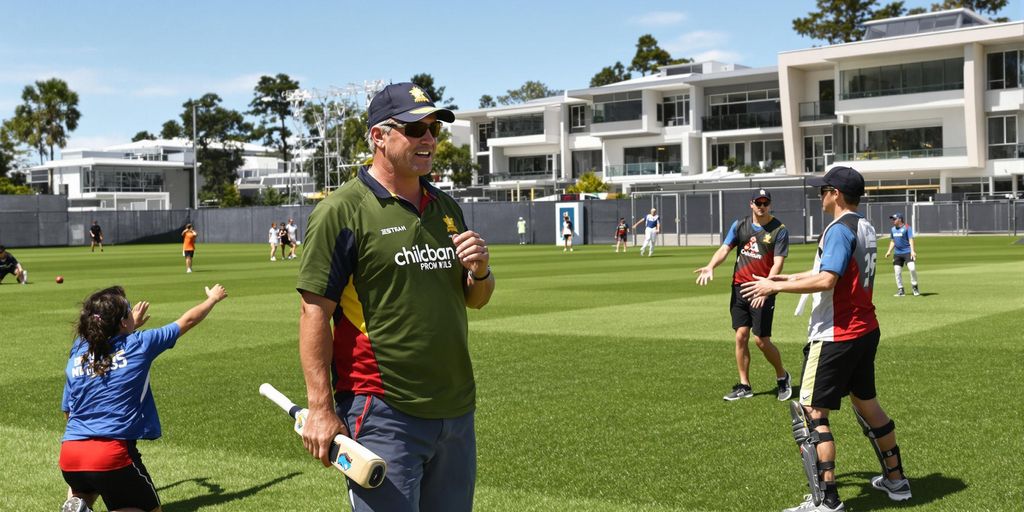The Role of the Australian Cricket Coach 2025

The role of the Australian cricket coach in 2025 is shaping up to be more complex than ever. It’s not just about winning games; it’s about building a sustainable future for Australian cricket. The coach needs to be a strategist, a mentor, and a leader, all rolled into one. They’ll need to navigate a rapidly changing cricketing landscape, both on and off the field.
Defining Coaching Philosophy
The coach needs a clear, well-articulated coaching philosophy that aligns with the values of Australian cricket. This isn’t just about tactics; it’s about instilling a winning mentality and a strong sense of team spirit. It’s about defining what it means to play cricket the Australian way in the modern era. This philosophy needs to be adaptable, allowing for individual player development while maintaining a cohesive team identity. It’s also about setting standards for behaviour and conduct, both on and off the field.
Adapting to Modern Cricket
Modern cricket is evolving at a rapid pace. The coach needs to be across all the latest trends, from data analytics to new training techniques. Adaptability is key. They need to be able to adjust their strategies based on the opposition, the conditions, and the evolving nature of the game. This also means being open to new ideas and approaches, and not being afraid to challenge conventional wisdom. The coach must also understand the impact of T20 cricket on the longer formats and find ways to integrate the skills and strategies from both. Teams like India have risen to challenge Australia’s dominance, making the format more competitive than ever. This shift in the cricketing landscape presents both challenges and opportunities for the Australian team as they look to maintain their status as a cricketing powerhouse.
Building Team Culture
Team culture is paramount. A successful coach needs to create an environment where players feel valued, supported, and empowered. This means fostering open communication, building trust, and promoting a sense of shared purpose. It’s about creating a culture where players are willing to go the extra mile for each other and for the team. This also involves managing egos, resolving conflicts, and ensuring that everyone is pulling in the same direction. Andrew McDonald is focused on future-proofing as the team heads toward a transition phase, planning gradual generational change with senior players ageing. McDonald emphasises the importance of balanced selection to ensure a smooth transition, leveraging 50-over cricket to groom future Test players.
The coach’s role extends beyond the field. They are responsible for creating a positive and supportive environment where players can thrive, both as cricketers and as individuals. This involves fostering a culture of respect, accountability, and continuous improvement.
Here are some key aspects of building a strong team culture:
- Establishing clear expectations and standards
- Promoting open communication and feedback
- Recognising and rewarding positive behaviour
- Addressing conflict constructively
Transitioning Generations in Australian Cricket
Nurturing Young Talent
Finding the next generation of Aussie cricketers is a big deal, especially with some of the older blokes getting on a bit. We need to make sure the young fellas are getting the right opportunities to shine. The Sheffield Shield and Big Bash are crucial for spotting and developing talent. It’s all about giving them a go and seeing who steps up.
Balancing Experience and Youth
It’s a tricky balancing act, this. You don’t want to chuck out all the experienced players at once, but you also need to blood the youngsters. Andrew McDonald is pretty focused on this ‘future-proofing’ thing, making sure we’ve got a good mix of old heads and fresh legs. It’s about keeping that knowledge in the team while giving the young blokes a chance to learn and grow. The Australian cricket team needs to find that sweet spot.
Lessons from Past Transitions
We’ve been through this before, of course. Remember when blokes like McGrath, Warne, and Gilchrist all retired around the same time? That was tough. We can learn from that.
The key is to plan ahead, identify potential replacements, and give them time to adjust to the international stage. It’s not just about finding players who can bat or bowl; it’s about finding players who can handle the pressure and maintain the Aussie spirit.
Here are some things we can do:
- Identify potential leaders early.
- Give young players exposure in different formats.
- Maintain a strong team culture to support new players.
Strategic Planning for the 2027 World Cup
Right, so the 2027 World Cup. It’s looming, and we need a proper plan to bring home the trophy again. It’s not just about having good players; it’s about having the right players and a strategy that’ll knock the socks off the competition.
Identifying Key Players
Finding the blokes who’ll actually perform under pressure is key. We need to look beyond just the stats and see who’s got the grit and determination to win. This means keeping a close eye on both established players and those up-and-comers in the domestic scene. It’s about building a squad with depth and versatility.
Developing a Winning Strategy
Mate, a winning strategy isn’t just about hitting sixes. It’s about understanding the conditions, knowing our opponents, and having a plan for every situation. We need to be adaptable and ready to change things up on the fly. This includes:
- Analysing past World Cup performances.
- Identifying key match-ups and potential weaknesses.
- Developing specific game plans for different opponents.
We need to create a strategy that plays to our strengths but also exploits the weaknesses of our rivals. It’s about being smart, not just strong.
Utilising Domestic Competitions
Our domestic comps, like the Sheffield Shield and the Big Bash League, are goldmines for finding and developing talent. We need to use these competitions to blood new players and give them the experience they need to perform at the highest level. The NSW Breakers are a great example of a team that consistently produces top-tier talent. It’s also about:
- Giving young players opportunities to shine.
- Monitoring player performance closely.
- Using domestic comps to trial different strategies and combinations.
Here’s a quick look at how we might track player progress:
| Player Name | Domestic Performance | Potential Role |
|---|---|---|
| Player A | High | Top Order |
| Player B | Average | All-Rounder |
| Player C | Promising | Bowler |
It’s a long road to 2027, but with a solid plan, we can get there. The Asian Games programme is also something to keep an eye on, as it can provide valuable experience for our players in different conditions.
The Impact of Leadership Changes
Influence of Andrew McDonald
Andrew McDonald’s approach is all about setting the team up for the future. He’s really focused on making sure the transition between generations is smooth, which is no easy feat. McDonald is aware of the challenges that come with an ageing team and is actively planning for a gradual generational change. He reckons that getting the selections right when senior players move on is key to a smoother transition. He’s using 50-over cricket to help groom future Test players, giving youngsters a chance to show their skills. It’s all about future-proofing the team.
Future Leadership Prospects
With blokes like Steve Smith stepping back from certain formats, it opens up opportunities for new leaders to emerge. Smith’s retirement from ODIs means the team needs to look ahead to the 2027 World Cup and start getting the next generation ready. This is a chance for new talent to step up and fill the gaps. The domestic cricket scene, like the Sheffield Shield and the Big Bash League, will be super important for finding and developing these players. It’s a balancing act between experience and youth as they build a team ready to defend their World Cup title. Identifying key players is crucial.
Coping with Player Retirements
Player retirements are just part of the game, but they can really shake things up. When a big name like Smith retires from ODIs, it has a ripple effect, not just for the Aussie team but for international cricket too. It can give other teams a chance to challenge Australia’s dominance, but it also puts pressure on them to step up. The team needs to adapt and find new ways to win.
It’s all about planning for the future and making sure there’s a solid base of talent ready to take over when the time comes. This means investing in young players, giving them opportunities to shine, and creating a team environment where everyone can thrive.
Here are some things to consider:
- Identifying potential leaders early.
- Providing mentorship opportunities.
- Creating a culture of shared responsibility.
Emerging Challenges in International Cricket
Rising Competitors
Mate, the world’s catching up! It’s not just us and the Poms anymore. India’s become a real powerhouse, and you’ve got other teams like Pakistan and New Zealand always nipping at our heels. Consistency is key, but it’s getting harder when everyone’s improving. We can’t just rely on past glories; we need to keep evolving.
Adapting to New Formats
Twenty20’s changed everything, hasn’t it? And now there’s talk of even shorter formats. It’s a different game, and we need to make sure our players can switch gears. It’s not just about slogging sixes; it’s about smart cricket, adapting to conditions, and having a plan B, C, and D. The rise of T20 leagues also means players are specialising more, which can impact their availability for other formats.
Maintaining Dominance
Staying on top is harder than getting there, that’s for sure. We’ve got to keep innovating, keep finding new talent, and keep pushing the boundaries. It’s about more than just winning games; it’s about building a system that can sustain success over the long haul. We need to look at how we’re developing players, how we’re using technology, and how we’re creating a winning culture. The chaotic calendar doesn’t help, but we can’t use that as an excuse.
It’s a constant battle to stay ahead. We need to be proactive, not reactive. That means identifying potential problems before they become major issues and having strategies in place to deal with them. It’s about being smart, being adaptable, and never taking anything for granted.
Here’s a few things we need to keep an eye on:
- Keeping our players fit and healthy.
- Developing a strong leadership pipeline.
- Staying ahead of the curve with tactics and strategies.
The Evolution of Training Techniques

Cricket training is changing, and it’s changing fast. Gone are the days of just running laps and hitting balls. Now, it’s all about data, tech, and getting into the players’ heads.
Incorporating Technology
We’re seeing more tech in cricket than ever before. Think about it: wearable sensors tracking player performance, video analysis breaking down batting techniques, and even AI helping to predict injuries. This isn’t just about looking fancy; it’s about getting real, measurable improvements. It’s like, remember when we just guessed if someone was tired? Now we’ve got the numbers to prove it.
Focus on Mental Resilience
It’s not just about being physically fit; it’s about being mentally tough. Cricket can be brutal, and the pressure is immense. So, we’re seeing more emphasis on things like mindfulness, visualisation, and even sports psychology.
Mental strength is now seen as just as important as physical prowess. Players are being taught to handle pressure, bounce back from setbacks, and stay focused even when things get tough. It’s about building a team of mentally resilient cricketers who can perform at their best under any circumstances.
Physical Conditioning Innovations
Physical conditioning has come a long way. It’s not just about lifting weights; it’s about tailored programmes that focus on the specific needs of each player. We’re talking about things like biomechanics, sports science, and even nutrition playing a bigger role. Players are fitter, faster, and stronger than ever before. The focus is on preventing injuries and future-proofing the team for the long haul.
Here’s a quick look at how things are changing:
- Old School: General fitness, basic drills, gut feeling.
- New School: Data-driven training, personalised programmes, mental skills training.
- The Goal: To create well-rounded athletes who are physically and mentally prepared for the demands of modern cricket.
The Importance of Team Dynamics
Fostering Team Cohesion
Getting a bunch of blokes and sheilas to play well together isn’t just about skill; it’s about how well they gel. Team cohesion is the glue that holds a winning side together. You can have the best batters and bowlers, but if they’re not on the same page, you’re cactus. This means creating an environment where everyone feels valued, respected, and part of something bigger than themselves. It’s about building trust and understanding, so when the pressure’s on, they back each other up, no worries.
Conflict Resolution Strategies
Let’s be real, disagreements happen. Whether it’s over a dodgy run call or a disagreement on strategy, conflict is part of the game. The key is how you handle it. Ignoring it just lets it fester, but blowing up isn’t the answer either. Having clear conflict resolution strategies in place is crucial. This could involve:
- Open communication channels where players can voice concerns.
- Mediation processes facilitated by the coach or a senior player.
- Team-building activities designed to improve understanding and empathy.
- Establishing clear guidelines for acceptable behaviour.
It’s about creating a culture where conflict is seen as an opportunity for growth, not a reason for division. When handled right, disagreements can actually strengthen team bonds.
Building Trust Among Players
Trust is the bedrock of any successful team. Without it, players are less likely to take risks, support each other, or perform at their best. Building trust takes time and effort, but it’s worth it. It’s about:
- Being reliable and consistent in your actions.
- Showing vulnerability and admitting mistakes.
- Supporting teammates both on and off the field.
- Celebrating successes together and learning from failures.
When players trust each other, they’re more willing to put the team first, knowing that their mates have their backs. And that’s when the magic happens.
Fan Engagement and Support
It’s no secret that keeping the fans happy is super important for Australian cricket. Without them, we’re just blokes hitting a ball around in an empty field. So, how do we make sure they keep coming back for more?
Enhancing Matchday Experience
Let’s be honest, sometimes going to the cricket can be a bit of a drag. Long queues, overpriced food, and seats that feel like they were designed for gnomes. We need to lift our game here. Think better facilities, shorter queues, and more entertainment beyond just the cricket itself. Maybe some live music, interactive games, or even just decent coffee. It’s all about making it a day out that’s worth the money. The NRMA Insurance men’s Ashes five-Test series is a great start.
Utilising Social Media
Social media is where everyone hangs out these days, so we need to be all over it. Not just posting scores and highlights, but actually engaging with the fans. Run polls, ask questions, get their opinions. Make them feel like they’re part of the team. We could even do live Q&As with the players or coaches. And for goodness sake, get some decent memes going. Everyone loves a good meme.
Building a Strong Community
Cricket isn’t just a sport; it’s a community. We need to build on that sense of belonging. Think about:
- Running more grassroots programmes to get kids involved.
- Hosting community events where fans can meet the players.
- Partnering with local charities to give back to the community.
At the end of the day, it’s about making cricket accessible and enjoyable for everyone. If we can do that, we’ll have fans for life.
The Future of Women’s Cricket in Australia
Growing Participation Rates
Things are looking up for women’s cricket in Australia! We’re seeing more girls and women picking up a bat and ball than ever before. This isn’t just happening in the cities; it’s spreading to regional areas too. Cricket Australia is putting a lot of effort into grassroots programmes, and it seems to be paying off. More players means a bigger talent pool, which is great news for the future of the national team. It’s awesome to see so many young girls getting involved in cricket participation.
Investment in Women’s Programmes
Cricket Australia is putting its money where its mouth is, with significant investment in women’s cricket programmes. This includes everything from improved training facilities to better pay for players. The increased funding is helping to professionalise the sport, making it a more viable career option for talented female cricketers. This investment also extends to developing pathways for young players, ensuring they have the support they need to reach their full potential. It’s a game changer, really. The investment is crucial for long-term success.
Promoting Female Role Models
Visibility is key, and having strong female role models in cricket is essential for inspiring the next generation. Players like Ellyse Perry and Meg Lanning are household names, and their achievements are helping to break down barriers and challenge stereotypes. Cricket Australia is actively promoting these players, showcasing their skills and stories to a wider audience. This increased visibility is not only inspiring young girls to take up the sport but also changing perceptions of women’s cricket in general. It’s about showing that cricket isn’t just a bloke’s game anymore.
It’s not just about the on-field action; it’s about creating a culture where women’s cricket is valued and celebrated. This includes promoting female coaches, umpires, and administrators, ensuring that women are represented at all levels of the game.
Here’s a quick look at some key areas of investment:
- Grassroots development programmes
- Elite player pathways
- Marketing and promotion of women’s cricket
- Improved facilities and resources
Sustainability in Australian Cricket
Cricket, like any sport, has a responsibility to consider its environmental impact and its role in the community. It’s not just about winning games; it’s about ensuring the sport thrives for generations to come.
Environmental Initiatives
Cricket Australia and state associations are starting to ramp up efforts to reduce their carbon footprint. This includes:
- Implementing water-saving measures at grounds.
- Using renewable energy sources.
- Reducing waste through recycling programmes.
- Promoting sustainable transport options for players and fans.
Community Engagement
Cricket is more than just a game; it’s a community. Engaging with local communities is vital for the sport’s long-term health. This involves:
- Running grassroots programmes to get more kids involved.
- Supporting local cricket clubs.
- Partnering with community organisations to address social issues.
- Ensuring cricket is accessible to everyone, regardless of background.
Long-term Vision for the Sport
Sustainability isn’t just a trend; it’s a necessity. Cricket Australia needs to develop a long-term vision that integrates sustainability into every aspect of the sport. This includes:
- Investing in research and development to find new ways to reduce the sport’s environmental impact.
- Educating players, coaches, and fans about sustainability issues.
- Working with sponsors and partners to promote sustainable practises.
By embracing sustainability, Australian cricket can ensure it remains a beloved sport for generations to come. It’s about playing our part in creating a healthier planet and a stronger community.
The Legacy of Australian Cricket Icons
Influence of Past Greats
Australian cricket is built on the shoulders of giants. Legends like Don Bradman, Dennis Lillee, and Shane Warne didn’t just play the game; they redefined it. Their records are amazing, but their influence on how Aussies approach cricket is even bigger. They set the standard for future generations, instilling a never-say-die attitude and a commitment to excellence.
These blokes showed us what it means to wear the baggy green. It’s about more than just stats; it’s about the spirit of the game and representing your country with pride.
Inspiring Future Generations
It’s not just about looking back; it’s about looking forward. The stories of these legends are told and retold to young cricketers all over Australia. They see what’s possible and dream of following in those footsteps.
- Cricket Australia runs youth programmes that highlight these figures.
- Coaches use their stories to motivate players.
- Families share tales of their heroics around the barbie.
These icons provide a tangible link to the past, inspiring the next wave of Aussie cricketers to strive for greatness.
Honouring Cricketing Heritage
We do a pretty good job of remembering our cricketing history. From the Bradman Museum to the annual awards ceremonies, there are plenty of ways we keep the flame alive. It’s important to remember where we came from, to appreciate the sacrifices and achievements of those who came before us. We need to keep telling these stories, so the next generation understands the rich history they’re a part of.
Here’s a few ways we do it:
- Maintaining cricket museums and halls of fame.
- Naming awards and trophies after legends.
- Celebrating milestones and anniversaries of significant events.
A New Era for Australian Cricket
As we close the chapter on Steve Smith’s ODI career, it’s hard not to reflect on the impact he’s had on the game. From a young all-rounder to a world-class batsman, his journey has been nothing short of inspiring. But with his retirement, we’re not just saying goodbye to a player; we’re stepping into a new phase for Australian cricket. The focus now shifts to building a team that can carry on the legacy he helped create. It’s about finding fresh talent, keeping the winning spirit alive, and gearing up for the challenges ahead, especially with the 2027 World Cup on the horizon. Fans are eager to see how the team adapts and grows in the coming years, and it’s sure to be an exciting ride filled with new faces and fierce competition.




